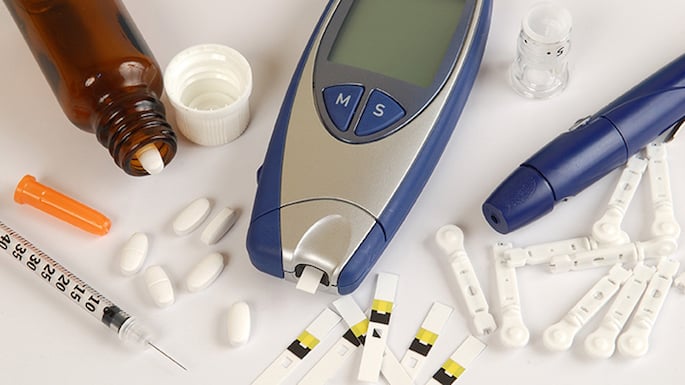
Type 2 diabetes mellitus (T2DM) is the most common type of diabetes, accounting for nearly 95% of all cases. Other types of diabetes are type 1 diabetes and gestational diabetes. T2DM is characterised by the presence of persistent high blood sugar due to the body’s resistance to insulin. Holistic treatments for type 2 diabetes include education, lifestyle modification and medications either orally or injection. Modifications include dietary changes, exercise and lifestyle improvement.
A plate of a healthy diet should consist of 40% fruits and vegetables, 25% proteins, 25% fibre-rich carbohydrates and 10% fats. Food containing high sugar and fat should be avoided at all costs. To avoid overeating, calculate the daily calories intake based on body weight. Recommended calories are 15 calories per pound for men, 13 for women and 10 for obese patients. Diabetic patients are also advised to lose weight. It is so effective that some were able to reverse diabetes just by losing weight. A study found 46% of diabetic patients who followed a strict weight loss program achieved remission (free of medication), with 86% of them losing more than 33 pounds in a year. Losing weight is also beneficial for obese patients as it not only improves blood sugar level but lowers blood pressure and cholesterol levels too. By subtracting 500 to 1000 calories a day, patients can safely lose around 1 to 2 pounds a week. Diabetic patients should also exercise regularly as it helps to lose more weight and improve insulin sensitivity. It is recommended to perform 30 minutes of aerobic exercises a day for at least 3 days per week. Lastly, patients should stop smoking, keep alcohol consumption at moderate amounts (2 servings per day for men and 1 for women) and get sufficient sleep.
Contrary to popular belief that adding on medication represents poorly controlled blood sugar, research showed that medications for diabetes should be initiated early as it helps to improve control of blood sugar and decrease long-term complications. Medications that are available to treat diabetes are metformin, sulfonylureas, DPP4 inhibitors, SGLT2 inhibitors, GLP-1 agonists and insulin. Most newly diagnosed patients are immediately started with metformin (like Glucophage or Glumetza) as it is effective in lowering blood sugar by reducing glucose production from the liver and increasing insulin sensitivity. Metformin is also preferred since it can be taken orally and does not cause weight gain and hypoglycemia. Take the pill with or after meals to minimise the side effects of metformin, which are nausea, diarrhea and gas. Patients who have kidney, liver and heart disease should not take metformin. If the blood sugar level and A1C is still high after 3 months of taking metformin, a second medication will be added on top of metformin.
A1C is glycated haemoglobin (red blood cells with sugar), a blood test that measures the average blood sugar level for the past 3 months. For most young diabetic patients, the A1C level is aimed at less than 7%. Lower A1C means lower risk to develop eye, kidney and nerve complications. If A1C is within 7 to 8.5%, the second medication is given orally, such as sulfonylureas, DPP4 inhibitors and SGLT2 inhibitors.
Sulfonylureas work by increasing the amount of insulin to lower blood sugar. It is inexpensive, effective and easily available but the side effects include hypoglycemia and weight gain. Do not take sulfonylurea if one has kidney and liver problems. Dipeptidyl peptidase-4 (DPP4) inhibitors like sitagliptin and vildagliptin work by increasing insulin production to lower blood sugar level. It does not cause weight gain and has minimal hypoglycemia effect. It can also be taken alone if metformin is not tolerated. The only downside of DPP4 inhibitors is the high cost. Sodium-glucose co-transporter 2 (SGLT2) inhibitors such as empagliflozin reduce blood sugar level by increasing the excretion of blood sugar in the urine. Studies found that its efficacy is similar to DPP4 inhibitors, but has additional benefits such as weight loss, lower risk of hypoglycemia and added benefits for heart problems and mild kidney disease. However, patients with kidney failure should not take SGLT2 inhibitors. Side effects of DPP4 inhibitors are genital yeast infection, urinary tract infection and dehydration.
For patients on metformin but has A1C higher than 8.5%, injection of insulin or GLP-1 agonists is given as a second medication. Insulin used to be reserved for uncontrolled blood sugar but there is evidence that insulin injection at early diabetes may improve overall diabetes control. There are several formulations of insulin where some are injected once a day while others are injected prior to every meal. Dosage of insulin should be adjusted to prevent hypoglycemia or weight gain. On the other hand, glucagon-like peptide-1 (GLP-1) agonists are injected only once a week. It works by increasing insulin after a meal and slowing digestion. Besides, it is beneficial for obese patients as it reduces appetite. Additionally, it has added cardiovascular benefits and does not cause hypoglycemia. The cons of GLP-1 agonists are the side effects of nausea, vomiting and diarrhoea, possible association with gallbladder disease and are much more expensive than insulin.
Diabetes is not the end of life. Although diabetes cannot be cured, a person can live a normal and fulfilling life with the help of lifestyle modification and medications. Just the patient must get regular medical checkups.






